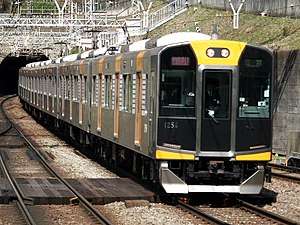Hanshin 1000 series
The Hanshin 1000 series (阪神電鉄1000系) is a commuter electric multiple unit (EMU) train type operated by the private railway operator Hanshin Electric Railway in Japan since 2007.[1]
| Hanshin 1000 series | |
|---|---|
 A 1000 series on a Kintetsu Nara Line "Rapid Express" service, March 2009 | |
| Manufacturer | Kinki Sharyo |
| Built at | Higashiosaka |
| Entered service | 2007 |
| Number built | 96 vehicles (22 sets) |
| Number in service | 96 vehicles (22 sets) |
| Formation | 2/6 cars per trainsets |
| Operator(s) | Hanshin Electric Railway |
| Line(s) served | |
| Specifications | |
| Car body construction | Stainless steel |
| Car length | 18,980 mm (62 ft 3 in) (end cars), 18,880 mm (61 ft 11 in) (intermediate cars) |
| Width | 2,800 mm (9 ft 2 in) |
| Height | 4,085 mm (13 ft 4.8 in) |
| Doors | 3 pairs per side |
| Maximum speed | 110 km/h (70 mph) |
| Traction system | Variable frequency (IGBT) |
| Power output | 170 kW per motor |
| Acceleration | 3.0 km/h/s |
| Deceleration | 4.0 km/h/s (service) 4.3 km/h/s (emergency) |
| Electric system(s) | 1,500 V DC |
| Current collection method | Overhead catenary |
| Braking system(s) | Regenerative brake, electronically controlled pneumatic brakes |
| Safety system(s) | Hanshin ATS Kintetsu ATS (old/new) |
| Coupling system | Shibata-type |
| Multiple working | 9000 series |
| Track gauge | 1,435 mm (4 ft 8 1⁄2 in) |
Design
The design was based on the earlier 9000 series trains, formed as six- and two-car sets.[1] The motored cars are mounted on SS171M bogies, and the non-powered trailer cars use SS171T bogies.[2]
Operations
The 1000 series sets are used on through-running services over Kintetsu lines, and are able to operate in multiple with 9000 series trains, running as up to 10-car formations.[1]
Formations
As of 1 April 2014, the fleet consists of thirteen six-car sets, numbered 1201 to 1213, and nine two-car sets, numbered 1501 to 1509.[3]
6-car sets
The thirteen six-car sets are formed as shown below, with three motored "M" cars and three non-powered trailer "T" cars.[2]
| Designation | Tc1 | M1 | M2 | T | M3 | Tc2 |
|---|---|---|---|---|---|---|
| Numbering | 1200 | 1000 | 1100 | 1300 | 1050 | 1250 |
| Weight (t) | 29.5 | 35.0 | 32.5 | 25.5 | 35.0 | 29.5 |
| Capacity Total/seated |
123/44 | 133/50 | 133/50 | 133/50 | 133/50 | 123/44 |
Each motored car is fitted with one PT7160-A single-arm pantograph.[2]
Interior
Passenger accommodation consists of longitudinal bench seating throughout, with sculpted seats finished in olive green moquette.[1]
History
The first train entered revenue service on 5 October 2007.
References
- 私鉄車両年鑑2012 [Japan Private Railways Annual 2012]. Tokyo, Japan: Ikaros Publications Ltd. February 2012. p. 55. ISBN 978-4-86320-549-9.
- 阪神電気鉄道1000系 [Hanshin Electric Railway 1000 series]. Japan Railfan Magazine (in Japanese). Vol. 47 no. 550. Japan: Koyusha Co., Ltd. February 2007. pp. 80–86.
- 私鉄車両編成表 2014 [Private Railway Rolling Stock Formations - 2014] (in Japanese). Japan: Kotsu Shimbunsha. 24 July 2014. ISBN 978-4-330-48414-3.
External links
| Wikimedia Commons has media related to Hanshin 1000 series. |
- Hanshin 1000 series official information(in Japanese)
- Hanshin 1000 series (Japan Railfan Magazine Online) (in Japanese)